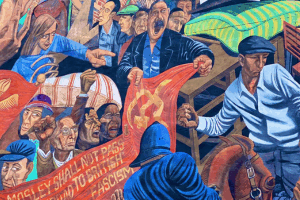Journée d’étude Printemps éthiopien, le 3 avril 2019 à l’INALCO

Vous trouverez en pièce jointe le programme de la journée, ainsi que le résumé, ci-dessous, de mon intervention de l’après-midi. Alain Gascon interviendra également. Pouvez-vous diffuser le programme et mon résumé sur le site de l’IFG, nous souhaiterions avoir un public nombreux et averti. Par avance merci,
Les conflits, souvent violents, réconciliations et recompositions identitaires dans l’Ethiopie d’Abiy, largement passés sous silence par les observateurs internationaux, sont indispensables à l’analyse géopolitique contemporaine de l’Ethiopie et de la corne de l’Afrique. Dans l’est éthiopien plus particulièrement, car ces territoires, essentiels au désenclavement du reste de l’Ethiopie, sont porteurs de grands projets d’infrastructures de production et d’interconnexion – corridors –. Les compétitions et recompositions politiques – donc identitaires – interviendront de ce fait dans l’issue des rivalités en cours entre les puissances régionales et mondiales dans la région et entre les Etats côtiers qu’il s’agisse de Djibouti, du Somaliland, de la Somalie ou du Kenya et inversement.
Les territoires somali et plus largement est-éthiopien sont toujours considérés politiquement (le SPDP n’est pas membre de l’EPRDF) et sociologiquement (pour essentialiser, population et élite politique musulmane, commerçante, nomade et transfrontalière) comme périphériques. Depuis l’arrivée d’Abiy Ahmed en avril 2018 et la destitution du président de l’Etat régional Somali d’Ethiopie en aout 2018 et en vue des élections de 2020, ils prennent toutefois leur place au centre du débat national et participent de manière plus visible à la construction de l’intégration régionale. Ils ne sont pas exempts de rivalités internes qui se jouent également à Addis Abeba et dans les Etats voisins. L’analyse propose ici de réintégrer le facteur identitaire dans le propos géopolitique, invisible dans l’étude stricte des relations internationales et pourtant clé de compréhension indispensable des relations entre Etats .
Partant de l’exemple de Dire Dawa pour étendre l’analyse aux pays voisins, on verra comment le destin de l’intégration politique comme économique de la corne de l’Afrique, et avec elle le(s) projet(s) de désenclavement éthiopien, est viscéralement (en référence à la géohistoire de la région) attaché aux évolutions de l’est éthiopien.
The often violent conflicts, reconciliations and identity reconfigurations in Abiy’s Ethiopia, widely ignored by international observers, shouldn’t be forgotten in the geopolitical analysis of today’s Ethiopia and Horn of Africa. In eastern Ethiopia in particular, because these territories, which are essential for opening up the rest of Ethiopia, carry major infrastructure projects for production and interconnection – corridors -. The competitions and political -therfore identity- recompositions in progress will intervene thereby in the outcome of the rivalries between the regional and world powers in the region and between the coastal states of Djibouti, Somaliland, Somalia or from Kenya and vice versa.
The somali territories and more widely eastern Ethiopia are still considered politically (the SPDP is not a member of the EPRDF) and sociologically ( to essentialize, population and political elite are Muslim, commercial, nomadic and cross-border) as peripheral. Since the arrival of Abiy Ahmed in April 2018 and the dismissal of the President of the Somali Regional State of Ethiopia in August 2018 and in view of the 2020 elections however, they take their place at the center of the national debate and participate more visibly in the construction of the regional integration. They are not exempt from internal rivalries that are also playing out in Addis Ababa and neighboring states. The analysis proposes here to reintegrate the identity factor in the geopolitical intention, invisible in the strict study of the international relations and nevertheless essential key of understanding relations between States.
Starting from the example of Dire Dawa to extend the analysis to neighboring countries, we will see how the destiny of the political and economic integration of the Horn of Africa, and with it the project(s) of Ethiopia’s opening up, is viscerally (in reference to the geohistory of the region) attached to the evolutions of eastern Ethiopia.



